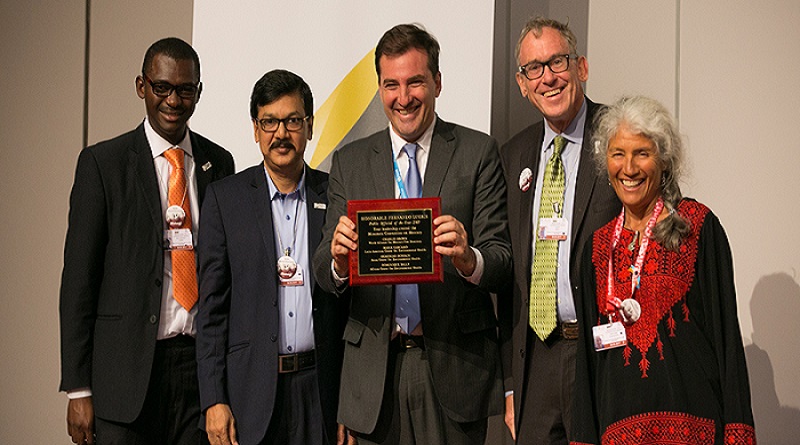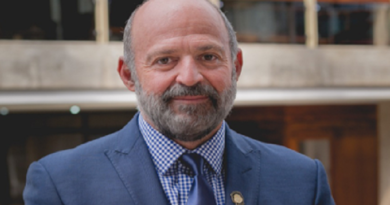Historic milestone reached as nations commit to fight against mercury pollution
In a landmark display of international cooperation, more than 160 countries committed to tackling one of the world’s greatest chemical health threats at the first meeting of the Conference of the Parties to the Minamata Convention on Mercury held from 24-29 September 2017, in Geneva, Switzerland.
The world’s first environmental and health treaty in a decade saw many countries pledge political and financial support to help reduce and eliminate mercury, a heavy metal affecting the health of millions of people worldwide from Guyana and Kiribati, to Uganda and Japan.
In her opening speech, the President of the Swiss Confederation, Doris Leuthard, described the Minamata Convention as a success of multilateralism, “The Minamata Convention is a global solution to a global challenge. From now on the name Minamata will no longer only be associated with a problem, but with a solution,” she said.
Opening the high-level segment, Erik Solheim Head of UN Environment said that in order to really address the mercury challenge solutions had to be integrated into public health and environmental strategies at all levels – from local to international – and embodied into the wider pollution control agenda. He called on ministers and delegates to use the tragic legacy of Minamata to propel the convention forward.
“We owe it to Minamata, to the people who suffered, to the people who ultimately made this day possible, to ensure that we never allow another tragedy like Minamata to occur again. And with the many technologies we have available now there is no reason why it should. We have the answers, we just need the political will to make it happen,” he said.
Taking stock of the conference, which came to a close on 30 September in Geneva, Marc Chardonnens, COP1 President and Switzerland’s Vice-Minister for Environment, said that the decisions taken would enable the States to start to implement the Convention at the national level. “The measures for reducing mercury emissions that pose a risk to health and the environment can begin,” he said.
During ‘Mercury Week’ dozens of activities and events cast a spotlight on what the World Health Organisation considers a top 10 chemical threat to human health. A ‘Mercury Drop’ installation and exhibition at the Place des Nations was visited by over 1500 people, and opened by the Mayor of Geneva.
A high level panel debate opened by the President of Guyana featuring the Head of the Global Environment Facility (GEF) Naoko Ishii, Erik Solheim, the Head of the United Nations Industrial Development Organisation, the Head of the United Nations Institute for Training and Research, and representatives from the United Nations Development Programme also drew attention to mercury use in Artisanal and Small-scale Gold Mining which accounts for up to 20% of the world’s gold supply.
“The first Minamata COP has been an important moment in global efforts to combat the menace of mercury pollution,” said Naoko Ishii. “At the same time, with partners like UN Environment and the active engagement of countries like Guyana, we’re making great strides at the local level to improve practices in the artisanal gold mining sector.”
Through the Global Opportunities for Long-term Development (GEF GOLD) programme, the GEF will provide funds to eight countries with a sizable gold mining sector, and where many artisanal miners still rely on mercury for gold extraction. The funding amounts to US$45.2 million and will be managed by implementing agencies, including UN Environment to support policies and market incentives that favour gold which uses less or no mercury in its extraction.
Several guidelines were adopted, in particular for the regulation of artisanal gold-mining and the reduction of mercury emissions in this sector. The States will receive support to enable them to gain a better understanding of the informal artisanal gold-mining sector and to make optimal use of the available state-of-the- art technology. Another guideline specifies how the atmospheric mercury emissions generated by coal-fired power plants, waste incineration plants and cement plants can be reduced.
On Thursday 28 September time was set aside for representatives of a variety of countries to hear the voices of Minamata disease victims and others, in an effort to prevent further tragedies such as the discharge of methyl mercury into Minamata Bay in the 1950s and 1960s. Embryonic Minamata disease victim Shinobu Sakamoto addressed a crowded room of delegates and media saying, “Please do not allow pollution to occur. Please protect women and children. Let’s (eradicate mercury pollution) together”.
Sixty-one year old Ms. Sakamoto last visited Europe 45 years ago when she conveyed the horrors of mercury poisoning at a United Nations conference on the human environment in Stockholm. She was a third-year junior high school student at the time.
Jacob Duer, Principal Coordinator for the Interim Secretariat of the Minamata Convention on Mercury said, “Entering this COP with 86 countries including the European Union having ratified the convention is a great achievement and a great start for the convention”
“We have more than 160 countries participating in this conference and more than 1300 participants. The numbers really speak for themselves, and make clear that this is not only a major milestone for the Minamata Convention, but for the environment, for human health, and for sustainable development.”
The Parties to the Minamata Convention on Mercury, which entered in to force on 16 August 2017, will now begin to implement the new global treaty which includes banning new mercury mines and phasing-out existing ones; regulating the use of mercury in artisanal and small-scale gold mining, certain industrial processes and the production of everyday items such as certain Compact fluorescent lamps, batteries and teeth fillings; as well as controlling the emissions of mercury as a by-product from a range of industrial sectors – including coal burning.
The Minamata Convention contains provisions that relate to the entire life cycle of mercury, including controls and reductions across a range of products, processes and industries where mercury is used, released or emitted. It also addresses primary mining of mercury, its export and import, its safe storage and its disposal once it is waste.
Under the Convention, countries are to: Control mercury emissions from key industries (including coal, waste incineration, non- ferrous metals, and cement production); Ban new mercury mining and close existing mercury mines after a period of time; Control trade in mercury; Work to reduce the use of mercury in artisanal and small scale gold mining – the largest source of mercury pollution and Promote international cooperation on mercury monitoring and innovation.



